
Grevillea petrophiloides, commonly known as pink pokers, rock grevillea or poker grevillea, is a species of flowering plant in the family Proteaceae and is endemic to the south-west of Western Australia. It is an erect shrub with divided leaves, the lobes mostly linear, and cylindrical clusters of usually pink to reddish pink and bluish-grey flowers.

Grevillea vestita is a species of flowering plant in the family Proteaceae and is endemic to the southwest of Western Australia. It is an erect, spreading, prickly shrub with lobed leaves, the number and arrangement of lobes depending on subspecies, and more or less spherical to dome-shaped clusters of hairy, white to cream-coloured flowers sometimes tinged with pink.
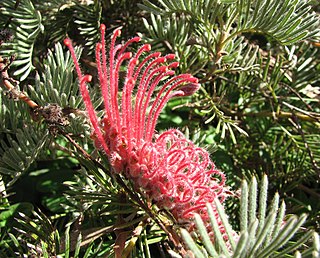
Grevillea thyrsoides is a species of flowering plant in the family Proteaceae, and is endemic to the southwest of Western Australia. It is a small, spreading or low-lying shrub, with pinnatisect to comb-like leaves, the end lobes linear, and clusters of hairy pinkish-red flowers.

Grevillea manglesii is a species of flowering plant in the family Proteaceae and is endemic to an area around Perth in Western Australia. It is a spreading shrub with divided leaves, with triangular or linear lobes, and clusters of cream-coloured or white flowers.
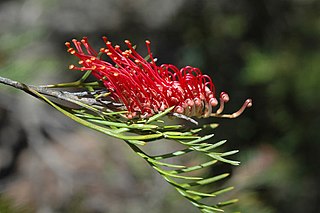
Grevillea hookeriana, commonly known as red toothbrushes or Hooker's grevillea, is a species of flowering plant in the family Proteaceae and is endemic to the south-west of Western Australia. It is a spreading to erect shrub, usually with linear leaves or deeply divided leaves with linear lobes, and toothbrush-shaped groups of red, black or yellowish green flowers, the style maroon to black.
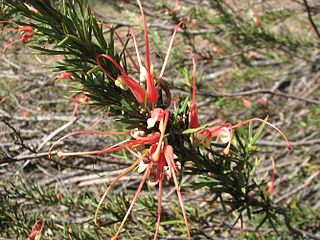
Grevillea tripartita is species of flowering plant in the family Proteaceae and is endemic to the south-west of Western Australia. It is an erect, prickly shrub with divided leaves with 3 lobes, and clusters of red and cream-coloured or reddish-orange and yellow flowers.
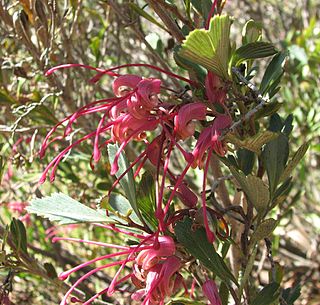
Grevillea pectinata, commonly known as comb-leaf grevillea, is a species of flowering plant in the family Proteaceae and is endemic to the south of Western Australia. It is a spreading shrub with divided, comb-like leaves and mauve-pink to red and cream-coloured to yellow flowers with a red to deep pink style.
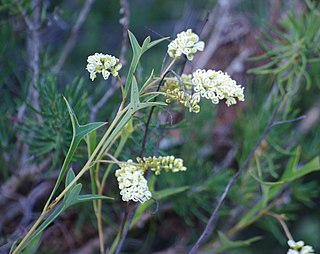
Grevillea synapheae, commonly known as catkin grevillea, is species of flowering plant in the family Proteaceae and is endemic to the southwest of Western Australia. It is a prostrate to erect shrub usually with divided leaves with 3 to 7 triangular to more or less linear lobes, and clusters of white to creamy yellow flowers.

Grevillea diversifolia, the variable-leaved grevillea, is a species of flowering plant in the family Proteaceae and is endemic to the south-west of Western Australia. It is an erect to prostrate shrub with simple or divided leaves and groups white to cream-coloured flowers with a dull red style.

Grevillea biformis is a species of flowering plant in the family Proteaceae and is endemic to the south-west of Western Australia. It is a shrub with linear leaves and cylindrical clusters of creamy white or pale pink flowers.

Grevillea plurijuga is a species of flowering plant in the family Proteaceae and is endemic to southern Western Australia. It is a prostrate to low-lying or dense mounded to erect shrub with divided leaves with linear lobes and loose clusters of hairy, red or pink flowers.
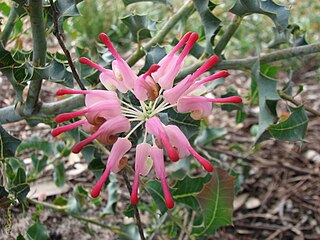
Grevillea insignis, commonly known as wax grevillea, is a species of flowering plant in the family Proteaceae and is endemic to the south-west of Western Australia. It is an erect, bushy shrub with more or less oblong leaves with seven to seventeen sharply-pointed, triangular teeth, and more or less spherical or cylindrical clusters of cream-coloured flowers ageing to pink.

Grevillea refracta, commonly known as silver-leaf grevillea, is a species of plant in the protea family and is native to northern Australia. It is a tree or shrub usually with pinnatipartite leaves and red and yellow flowers arranged on a branched, downcurved raceme.

Grevillea hakeoides is a species of flowering plant in the family Proteaceae and is endemic to the south-west of Western Australia. It is a spreading shrub with flat, linear or more or less-cylindrical leaves and dome-shaped groups of flowers, the colour varying according to subspecies.

Grevillea muelleri is a species of flowering plant in the family Proteaceae and is endemic to the a relatively small area of south-western Western Australia. It is a shrub with linear to narrowly oblong, or divided leaves with linear or narrowly egg-shaped lobes, more or less spherical clusters of white to cream-coloured flowers.

Grevillea obliquistigma is a species of flowering plant in the family Proteaceae and is endemic to the south-west of Western Australia. It is a spreading shrub with linear leaves, and conical to cylindrical clusters of creamy-white to yellowish cream-coloured flowers, sometimes tinged with pink.

Grevillea patentiloba is a species of flowering plant in the family Proteaceae and is endemic to the south-west of Western Australia. It is a prostrate to erect, spreading to straggling shrub with divided leaves, and down-turned clusters of red to deep pink and cream-coloured to bright yellow flowers with a red to deep pink style.

Grevillea prostrata, commonly known as the Pallarup grevillea, is a species of flowering plant in the family Proteaceae and is endemic to a small area in the southwest of Western Australia. It is a prostrate shrub with more or less pinnatisect leaves and pink and white flowers with a white style.

Grevillea neodissecta is a species of flowering plant in the family Proteaceae and is endemic to Western Australia. It is low, dense shrub with deeply divided leaves, the end lobes linear and sharply pointed, and small clusters of rose pink and white to cream-coloured flowers with a pinkish-red style.
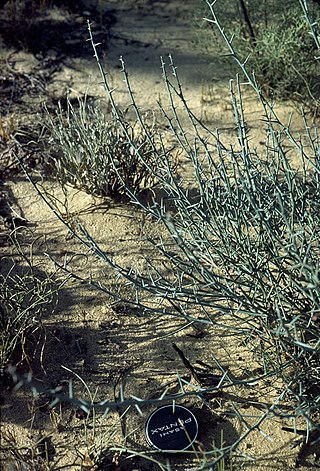
Daviesia sarissa is a species of flowering plant in the family Fabaceae and is endemic to inland areas of south-western Western Australia. It is a spreading or sprawling, glaucous shrub with scattered, long, rigid, cylindrical, sharply-pointed phyllodes, and orange-yellow and red flowers.





















